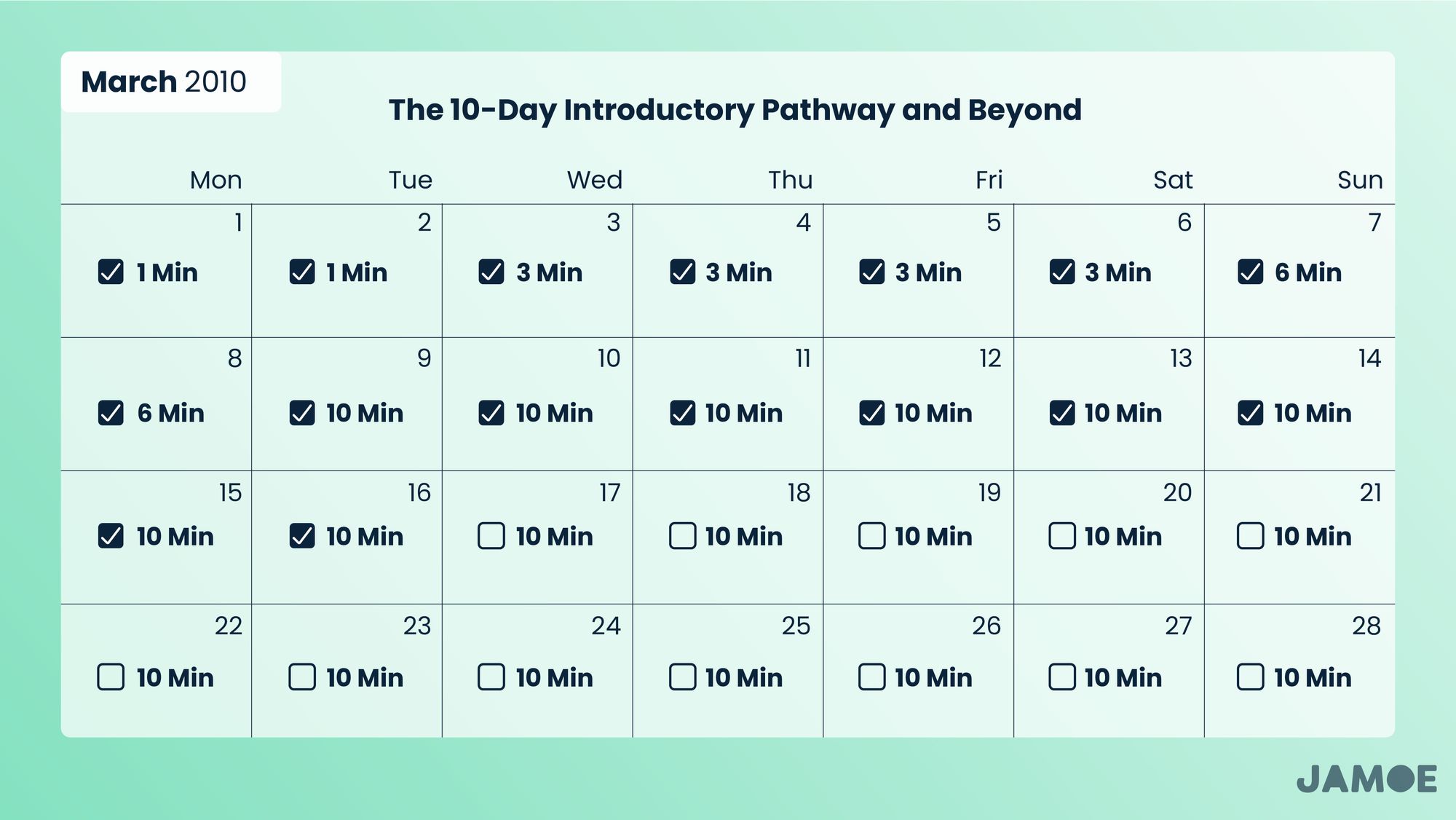4:6 Breathing for Focus and Calm
At a glance
- The quality of our feelings affects the quality of our thinking. How we feel, however, based on an increasing wealth of clinical studies, is a skill. We can, far more than we might expect, direct our mood to overcome challenges like procrastination, anxiety, short attention spans and a lack of motivation.
- The ideal state is to be calm and alert. Balancing the research with what’s practical, we’ll share the small and mighty 4:6 breathing technique. It’s simple, and the only equipment you need is your breath (and maybe your hands).
- After sharing the technique, we’ll offer a guided tour of the research, so you can understand how neuroscientists and psychologists make sense of the connection between our breathing, emotions and nervous systems.
Introduction
Our mood sits, often unacknowledged, at the root of so many challenges we face. We sense pain or danger in our mind's eye, so we procrastinate or get hit by stage fright. Aside from running away, our choices are two-fold: we can either practice enduring discomfort or find a way to make the whole situation less painful.
In this piece, we're going to focus on making situations less painful with the help of a breathing technique. The technique will give you one more way to avoid getting stuck in a rut, allowing you to get more from your studies and career.
Mystic rubbish or a great idea we struggle to make stick. That's what most people think when the topics of breathing and mindfulness come up. We've written this guide with both groups in mind by applying a scientific filter to soothe the sceptics and selecting an effective technique that overcomes the main reason we break habits: complexity.
The outcome is a brighter, calmer and more focused mood, making all aspects of life, whether you're learning, creating or just hanging out, less painful and more pleasant.
It's a tree we wish we'd planted sooner because it reveals that feeling calm and alert is a skill, not an accident. Embracing this means we can steer our emotions and avoid being taken for a ride.
The technique in a nutshell
We call it the 4:6 (read 'four six') breathing technique: breathe in for 4 seconds; breathe out for 6 seconds. That's it. There's no app, special mantra or convoluted ritual. Just sit down, breathe, and benefit.
While mindfulness apps have their advantages, they're often tied to distracting devices, dividing our attention with their beeps and boops. Paying attention is key to all mindfulness techniques, so this app-free alternative will help you escape your phone's gravity.
The specific steps involved are:
- Sit comfortably and with integrity on a chair or the floor.
- Set a timer for either 1, 3, 6 or 10 minutes.
- Close your eyes.
- Breath in deeply through your nose for 4 seconds; count each second.
- Breath out fully through your nose for 6 seconds; count each second.
A note on nasal breathing: breathing through your nose will help you breathe more evenly. If you can't breathe through your nose, using your mouth is fine.[1]

How long to make a session
You can jump into whatever session length you think will be most comfortable. However, we recommend the following 10-day introductory pathway:
- Day 1–2: 1 minute
- Day 3–6: 3 minutes
- Day 7–8: 6 minutes
- Day 9–10: 10 minutes
We've designed the introductory pathway like this so you can see what it feels like to sit for 10 minutes and benchmark your current levels of focus. It also makes climbing the learning curve faster, so you can worry less about doing it right and instead focus on your breath.
Once you've graduated from the pathway, continue practising with the session length you were able to remain most attentive. When you're comfortable with this, move onto a longer session.
We recommend building a habit around the 10-minute session, but the most important thing is turning up. If you only have time for a 3-minute session, do that.
Avoiding digital timers with fingers and thumbs
It's a welcome coincidence that every repetition is 10-seconds. To deepen your focus, you can avoid digital timers (and escape your phone's gravity) by counting each repetition on your fingers and thumbs.
Using all ten digits will give you a soothing 100-second session. For something longer, you'll need to be more creative with how you count. With a fairly easy tweak, you can comfortably count up to 1,440-seconds, or 24 minutes.[2]
Beyond keeping track of time, we also recommend counting to anyone with an incredibly distracted mind. Like how focusing on a single spot helps with balancing on one leg, focusing on a single task makes it easier to avoid bumbling.
You'll also become more aware of when you've bumbled, allowing you to refocus your wandering mind on your breath, which is all part of growing and deepening your attention span.
How long until you'll notice the benefits
You'll notice a change to your state of mind immediately after a session, and then it may fade. However, the longer you sustain the habit, the longer you'll be able to carry that state of mind with you.
Looking at the research, observable changes to the body's physiology (hormone levels, cognition, attention span) range from 5 days to 3 weeks. Upon reaching this tipping point, you'll find it easier to carry a sense of calm and alertness with you into your day-to-day life.
It's similar to how we carry the benefits of improving our physical fitness into defeating everyday obstacles: lifting boxes, climbing stairs or opening pickle jars.
However, as with physical fitness, it's something you need to practise regularly.
How often do you recommend practising
Practising once per day was enough for the exercise to cause a significant change in the majority of the studies referenced below.
However, the technique is yours to integrate into your life as needed. Being an on-demand tool, you can use it whenever you need to offload stress, such as when going to sleep, focusing on a task or before a high-stakes event.

The technique's finer details
How to breathe correctly: you want to breathe from your diaphragm. You can tell you're doing it right by putting a hand on your stomach and breathing in. Your stomach should expand like a balloon, and your chest and shoulders shouldn't move.
How to deal with a wandering mind: slow controlled breathing allows you to feel calmer, while counting the breath allows you to hone your focus. Whenever you catch your mind wandering off, bring it back to counting your breath. Avoid berating yourself. Instead, treat your straying attention with the same gentleness you'd use to bring home a wandering kitten. The kitten isn't doing anything wrong; it's just used to exploring. With time, all those gentle nudges will add up to a much sharper and more enduring focus.
How to avoid feeling light-headed: if you feel light-headed, stop. While the technique has you breathing out for longer than you're breathing in, the amount of air inhaled and exhaled should be the same. That is, you breathe the same amount of breath; it's just the time you spend inhaling and exhaling that differs.
How to sit with integrity: roll your shoulders back and avoid slouching. You can imagine an invisible string pulling you upright from the crown of your head. On a chair, you may find it easier to sit on the seat's edge, as it'll give your lungs more space, making it easier to breathe.
What to do with your hands: position your hands in whatever way is comfortable. Placing them in your lap is a good starting point. We recommend putting one hand on top of the other with the palms facing up.
How to warm up: warming up helps avoid the inconvenience of settling into a session just as it ends. Our simple tip is to complete two sessions, where the first is a 1-minute warm-up. It will blow out the cobwebs and, once you've reset, allow you to settle into your "official" session faster.
Unpacking the science
Understanding how our breath can influence our mind and body has been an expanding area of research in the fields of neuroscience, psychology and medicine.
Making sense of the research requires being familiar with a few key concepts. The body has two states: fight-or-flight and rest-and-digest. The first state is when our sympathetic nervous system is dominant, while the second is when our parasympathetic nervous system is dominant.
The sympathetic nervous system prepares the body for stress-related activities, while the parasympathetic nervous system helps the body relax back into routine tasks. Being in a stressed state means these routine tasks get neglected, which is why so many health problems arise from long-term stress.
This broader nervous system keeps functions like our heart rate, digestion, mood, and breathing running on autopilot. However, of all the functions governed by our nervous system, there is one that we can manually override: the breath.
By manually overriding our breath, we can guide the functions governed by our nervous system towards a healthier balance. This includes steering ourselves into a relaxed but alert state by making our parasympathetic nervous system dominant. Researchers measure the dominance of our parasympathetic nervous system using something called vagal tone.
Vagal tone refers to the vagus nerve (pronounced like 'Vegas' in 'Las Vegas'), which is the main component of the parasympathetic nervous system. Having a high vagal tone is correlated with a more positive mood and a greater capacity to regulate our stress response.
The use of vagus nerve stimulation to treat extreme cases of depression best captures the importance of the vagus nerve in regulating how we feel. One of the original experiments involved surgically implanting a device to stimulate the vagus nerve using electrical signals.[3]
The stimulation increased the vagal tone in most patients and reduced the symptoms of depression. The experiment validated the strong connection between the vagus nerve and our mood leading to the US and many European countries clinically approving this form of treatment.
However, the research has also made increasing one's vagal tone using non-invasive methods, like controlled breathing, a clinical alternative for those experiencing more treatable forms of anxiety and depression.[4] But what are the effects of increasing the vagal tone of healthy people?
Looking across the literature, whether participants practised slow controlled breathing for 5 days or 3 months, they had an elevated mood, a measurably lower amount of cortisol, the stress hormone, and an ability to focus for longer.[5]
The optimal way to increase our vagal tone with slow controlled breathing
An article by the European Respiratory Society reviewed 119 research papers to identify the main physiological effects of breathing in healthy humans, including how it changes our vagal tone.
The review concluded by highlighting that slow controlled breathing is the optimal way to regulate our stress response by increasing our vagal tone. Practically, that meant people were able to sustain a mental state that was both calm and alert.[6]
Slow controlled breathing is anything between 4–8 breaths per minute. For comparison, the average person takes 12 breaths per minute. When suggesting an optimal technique for slow controlled breathing, the research recommended adopting a technique that sits between 6–10 breaths per minute (the 4:6 technique is 6 breaths per minute).
The 6–10 breaths range had the strongest correlation with higher levels of oxygenation, an increased vagal tone, and being able to maintain a parasympathetic-sympathetic balance for feeling calm and alert.
These studies explain the apparent contradiction in being able to feel both calm and alert at the same time. When parasympathetic activity becomes more dominant, it does not mean our sympathetic system has switched off altogether. Instead, the two systems move closer to an optimal balance that offers us an enhanced reactivity to physical and mental stresses, whether that's exercising, completing an exam or dealing with an emergency.[7]
Conclusion
Our breath offers us a way to achieve a brighter, calmer and more focused mood. With the quality of our minds being the quality of our lives, directing our mental state makes tackling challenges like procrastination, worry, a lack of motivation and a wandering mind far easier.
A vote of confidence for the power of breathing techniques is their increasing role in medicine. We've focused on anxiety and depression in this piece, but the breath's connection to our nervous system means the benefits of controlled breathing are far more expansive.
With our nervous system being the control centre for our mind and body, studies are also exploring the role of controlled breathing in overcoming disorders related to respiration, digestion and improving immunity.[8]
Once again, the vagus nerve appears in most of these studies and studies seeking to understand the mechanics behind the benefits of exercising and taking cold showers.
However, given these activities aren't always accessible (or warm), the breath remains our favourite way to inspire sharper thoughts and lighter feelings.
Footnotes
[1] Nasal breathing has many other advantages. It's the body's natural filter with nasal hairs and mucus stopping things like allergens and pollutants from reaching your lungs. The air passing through your nasal passage is also warmer and moister, making it easier for the lungs to work with. However, the fascinating part is that nasal breathing prompts the body to release more nitric oxide (NO). NO is a vasodilator, so it widens blood vessels, improving oxygen circulation.
[2] So you want to unlock the full counting potential of your hands? Watch the first 01:13 of this TED-Ed video to learn how to count up to 144. If you use this to mark each 4:6 breathing repetition, that's 1,440-seconds (24 minutes). Feel free to watch the rest of the video if counting to 59,048 is valuable. With it, you'll be able to measure 590,048-seconds (almost 164-hours), which might be too long, but you do you.
[3] See this paper for an analysis of the two-year experiment of vagus nerve stimulation for those with treatment-resistant depression. Treatment-resistant means that all other clinical paths, such as drugs or therapy, were ineffective. For a broader look at the connection between the vagus nerve and depression, see this paper.
[4] In this clinical trial, they had patients suffering from lung disease, chronic obstructive pulmonary disease (COPD), practice slow controlled breathing to help them overcome feelings of anxiety and depression.
[5] For an overview of slow controlled breathing's relationship with improving focus, see this study. If you're specifically interested in the short-term study, see here; the long-term study is here. The short-term study had participants complete one 20 minute session for 5 days. The result was an elevated mood, lower cortisol levels, and an increased performance at the Attention Network Test, the accepted way of measuring the three components of attention. The long-term study took place over 3 months and required participants to practice for 5 hours a day; the results echoed those of the short-term study.
[6] The literature review can be found here.
[7] The results from this study improved our understanding of the mechanisms involved in enhancing our stress response. Instead of slow controlled breathing reducing our sympathetic activity (fight-or-flight), it appears to allow us to achieve an optimal sympathovagal balance, which improves our ability to react to physical and mental stresses while remaining calm.
[8] This study explores why the vagus nerve is an attractive target in treating psychiatric and gastrointestinal disorders.




